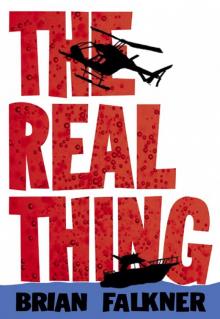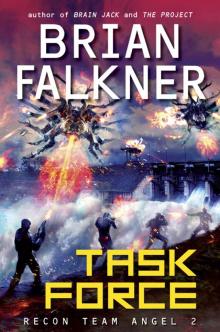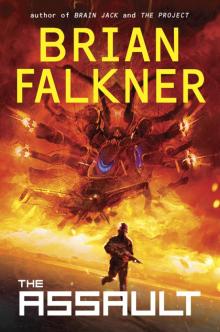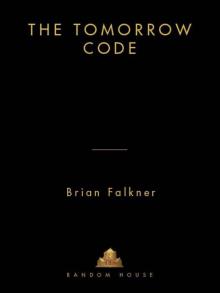- Home
- Brian Falkner
Brain Jack Page 3
Brain Jack Read online
Page 3
When they restored the backup files to replace the ruined database, they would be unwittingly putting his data right where he wanted it.
The last thing he did before sending a self-destruct signal was to leave traces of a digital signature that he had stolen from a Turkish hacker. Ghillie disappeared as if it had never existed.
He grabbed the parabolic antenna, flattened its wings, and threw it into his backpack. He hit the Shutdown button on his laptop.
“Someone just ran outside with a radio direction finder!” Fargas yelled. “Now they’re all heading right your way.”
Sam was already moving. He was at the rear of the cafe, by the washrooms, when the guards burst through the front door. He ducked across the hallway into the cafe’s small kitchen, throwing on a baseball cap and a pair of sunglasses as he did so, running past the hot plates and startled chefs to the service entrance at the rear.
He emerged onto Trimble Place, looking back again and again but seeing no sign of pursuit. A police Humvee went past him at speed, siren wailing.
He was so engrossed in what was, or wasn’t, behind him that he completely failed to notice the security camera, mounted high on a telegraph pole, that turned to follow him as he scurried along Trimble Place. He walked a little more steadily down Duane Street, eventually losing himself in the crowds thronging their way to work along Hudson Street.
Slowly, Sam’s breathing began to calm. He checked his watch and increased his pace, partly to put in more distance from the scene of the crime and partly because he was late.
It was 8:52 a.m.
Time for school.
3 | CHAOS
At exactly 8:59 a.m., as Sam Wilson was walking through the main entrance to his school—nodding to the security guards, who ignored him, and smiling at their aggressive-looking guard dogs, which snarled at him—a series of catastrophes was striking the largest telecommunications company in America: Telecomerica.
The scrambled database server was bad enough, but two nasty little viruses, the Black Flu and Kamikaze, chewed their way through node after node on the network as the system administrators and the antivirus software struggled to contain them.
Servers had to be shut down and rebuilt from scratch to eliminate the intruders and repair the damage.
The Thomas Street facility infected the Washington, D.C., office, which spread the disease right up and down the East Coast, as far south as Miami, from where it raced across the nation, via Albuquerque to San Diego, and quickly spread up and down the West Coast as well.
It wasn’t simply the Internet that went down, although that collapsed in a screaming heap right across the country and in many other places around the world as all the main U.S. circuits imploded. The internal networks of banks and major corporations used the same circuits. Most had to close their doors.
TV stations went off the air. Radio stations broadcast static. ATMs all went off-line. The stock exchange ground to a halt. The loss of the Internet meant the loss of e-mail and instant messaging. Cell phones just roamed aimlessly, looking for networks that no longer existed. Text messages sat uselessly in outboxes. Entire regions lost basic telephone services as the sickness found its way into other networks. Some parts of the United States even lost power.
Still, nobody died. There was the occasional injury when the lights went out, and there was some rioting in Los Angeles—what was now referred to as PVPS, or post-Vegas panic syndrome—but there were no fatalities.
It took three days to sort out the chaos and get America back online.
4 | URSULA
The delivery guy piled all the boxes in a stack by the door of Sam’s apartment and handed over a PDA.
They had been waiting for this delivery for over a week.
In the immediate aftermath of the Telecomerica hack, there had been no chance of it. America had been pretty much at a standstill. At least they hadn’t lost power, unlike some states. Three days of darkness, cold showers, and no computers would have been too much to bear, Sam thought. Especially when it was your own fault!
But things had gradually returned to normal. Phones. The Internet. Deliveries.
He felt sweat break out behind his ears as he signed on the electronic screen, accepting the goods.
If they had gotten away with it, or not, this was the time they would find out.
But the delivery guy just turned and headed back to the elevators.
“Cool!” Fargas said behind him.
“Let’s get it inside,” Sam said, grabbing two of the boxes off the top. “We’ve only got a couple of hours before the convention starts.”
The elevator doors opened as he did so. Louis, the bratty fourteen-year-old from 602, got out with a couple of his longhaired Guitar Hero friends as the delivery guy got in.
If there was ever any doubt about whether humankind had descended from the apes, Sam thought, Louis was living proof. He and his gang clearly hadn’t descended as far as most other people.
“Geek alert,” Louis said immediately. “Nerds in the open.”
His buddies laughed. Sam ignored him and handed the boxes to Fargas.
“Whatcha got in the boxes?” Louis said. “Geek stuff? Are you building a robot in there?”
“Why don’t you thump him?” Fargas asked.
“Why don’t you thump him?” one of Louis’s friends mimicked.
“Ignore him,” Sam said. “His brain’s not developed enough to argue with.”
He picked up the remaining boxes and shut the apartment door with his foot as Louis struggled with a reply.
“Are you building a robot girlfriend?” Louis asked loudly in the corridor as the door closed in his face. “Can’t get a real one.”
Sam carefully negotiated the narrow and crowded hallway of the apartment with the two cartons.
“What’s your mom gonna say about all this stuff?” Fargas asked several minutes later.
“All this stuff” was the cardboard boxes, polystyrene, and other assorted packaging for two new laptops, two Neurotech neuro-headsets, and a variety of software.
Sam folded the last of the large brown boxes flat and stacked it with the others against the wall by the window, next to the computer desk with his much older, much slower, laptop.
The desk itself was tidy, as was the rest of the small bedroom, with shoes arranged in a row inside the closet, a perfectly made bed, and rows of books, sorted by size and shape on a three-shelf bookcase against one wall.
A foot-long model of Thunderbird 2 sat on top of the bookcase, lined up with the USS Enterprise, the original shape from the original TV series.
Fargas was sitting on the floor, one of the new laptops on his knees and a neuro-headset next to him beside an open bag of caramel corn.
“Mom never comes in here,” Sam said. “It’s like my own apartment.”
“And my mother hunts moose on Mars with a popgun,” Fargas said, reaching out a hand to the caramel corn. Sam tried not to wince as Fargas put his sticky caramel fingers back on the computer keyboard.
“No, really—”
“Hey, dude, this chick is awesome!” Fargas said.
On Fargas’s laptop screen was a picture of a stunningly beautiful girl wearing a neuro-headset.
Sam looked at his own new equipment, in shrink-wrapped cartons, now laid out neatly on his bed.
He quickly opened and powered up his new laptop, then turned his attention to the other carton.
NEUROTECH NEURO-CONNECTION PACK was emblazoned across the top and SAY GOODBYE TO YOUR KEYBOARD AND MOUSE in a flashy graphic at the lower right.
The shrink-wrap disappeared with a couple strokes of his penknife, and he opened the carton.
On the top, in a flat section of the inner packing, were the manual and a Blu-ray of the software. He put them to one side.
Below were some cables and other paraphernalia that he couldn’t identify just yet, and underneath another layer of cardboard was the prize itself.
He lifted it out and ex
amined it. It was the first time he had seen a neuro-headset up close. They were still quite expensive, certainly out of the budget of a high school student, although admittedly, they were getting cheaper all the time.
It looked most of all like a swimmer’s cap, except for the slight protuberances that were the receptors. From each receptor a thin wire emerged, running backward across the cap to the base of the neck, merging into a thick black wire that ended in four separate, multipinned plugs, each a different color.
Under the next layer of cardboard in the carton he found the receptor box. Gunmetal gray, it was the size of a box of chocolates. It was the biggest, heaviest thing in the carton. On the rear of the receptor device, there were four sockets, color-coded to match the plugs.
He studied the instruction manual before connecting the cables and plugging the connector into the USB3 slot on his new laptop.
He inserted the Blu-ray into the drive and installed the software, then, with a growing sense of excitement, he slid on the headset.
And nothing happened.
There was no strange sensation within his skull. No sudden flash of oneness with his computer. Nothing.
He looked over at Fargas, who was wearing his headset and playing some kind of simple game involving airplanes.
He loaded the training software and followed the setup wizard, agreeing to the terms and conditions (without reading them) and selecting all the default options.
The Blu-ray drive whirred for a moment, and his screen went entirely black, changing resolution before a face appeared on his screen. The young woman from Fargas’s computer. She was gorgeous but with a slight plasticity of skin and an unnatural smoothness of movement that showed she was computer generated rather than a real person.
“Hello,” she said in a honey-sweet voice that was entirely too natural to be simmed. A real person must have recorded the dialogue. “My name is Ursula,” she said.
“Hi, Ursula, I’m Sam,” Sam responded, knowing that she could not hear him.
“I’ll be your tutor and guide as you discover a whole new way to operate your computer, connect with friends and family, and access the Internet. Your brand-new neuro-connection,” Ursula said.
“You’re right. She’s awesome,” Sam said.
Fargas looked over. “Reckon she gives private lessons?”
“She’s not real, dude. Just a bunch of pixels,” Sam said.
“Works for me,” Fargas said.
Sam laughed. “If she was real, I’d love to meet her.”
“Get in line,” Fargas said.
Ursula continued, “Your neuro-connection will allow you to put away your keyboard and mouse, and eventually even your computer screen, and interact with your computer simply by using your brain. If you haven’t already plugged in and attached your headset, do that now. I’ll wait,” she said with a beguiling smile, then added, “If you need help with any of the equipment, press F1 now. When you are ready, press Enter.”
Sam did exactly that.
Ursula’s face shrunk to the top right of the screen, and a graphic appeared, a three-dimensional image of the headset, rotating slowly.
“You are now wearing the latest technology Neurotech 1.2 headset. Embedded sensors detect signals produced by your brain that you know as brain waves.”
Sam ran a hand over his head, feeling the slightly raised bumps on the headset.
“There are four main types of brain waves: alpha, beta, delta, and theta,” she said. “The ones we are interested in are the higher-frequency but low-amplitude waves, known as beta waves.”
The graphic changed to show a colorful chart, a little like a topographical map.
Ursula said, “Beta waves are unique to each individual; however, certain patterns are common to all people. By detecting those common patterns and training our patented Neuro-Sensor software to recognize your own individual patterns, it is a simple and easy process to control your computer, just with the power of your own mind. If you have ever used speech-recognition software, this is a quite similar process.”
Her face disappeared altogether, and a screen appeared that looked like a scene out of a video game. The graphic showed a dog standing on a long winding pathway through a park. Each side of the path was lined with a row of small shrubs.
Ursula spoke. “Steer left and right to stay on the path. Concentrate on making the dog move. Focus on the dog and mentally turn it the way you want. When the dog turns to the left, press the ‘L’ key on your keyboard. When it turns to the right, press ‘R.’ This will help train the Neuro-Sensor software to recognize your brain-wave patterns for left and right.”
The dog started walking. The path began to curve to the left.
Sam focused on the dog and willed it to turn. It didn’t. He tried to move the dog with his eyes, as if he could pick up the dog with his gaze.
The dog walked into the shrubs and stopped.
“Let’s try that again.” Ursula came back on-screen with an encouraging smile.
“Imagine you are the dog,” Fargas said, “and it is you that is turning to the left or right.”
“Woof,” Sam said.
The dog reappeared at the start of the path. Sam tried to imagine he was the dog, but still the dog walked into the shrubbery and stopped.
“Don’t give up; you’re doing well,” Ursula lied cheerfully. “Press Enter to try again.”
Ten minutes later, he was starting to get sick of Ursula and her happy, happy attitude. A couple of times the dog had flickered a bit, as if it was trying to turn one way or the other, but that was the best he had achieved.
“Try again,” she kept saying.
“I hate dogs,” Sam growled.
“I know what your problem is,” Fargas said.
“What?”
“No detectable brain waves.”
“I’m starting to wonder,” Sam said.
“Try turning your whole body,” Fargas said. “That’s what worked for me at the start.”
Sam stood up and this time simply turned his whole body to the left.
To his utter amazement, and no small relief, the dog turned hard left and crashed into the shrubs on the other side of the path.
Sam stabbed at the “L” key.
Ursula’s face appeared for a moment on the screen with a huge smile. “Great work!” she said, and winked.
“I think she fancies you,” Fargas said.
“I have that effect on women,” Sam said.
Fargas laughed and filled his mouth with caramel corn.
Sam tried again, turning to the left or the right, and found that he was able to keep the dog on the winding path for quite long periods. More importantly, though, after he had pressed the “L” and “R” keys a few times, he realized that he no longer had to turn his body physically to make the dog turn. If he just thought about turning, the dog moved in that direction.
After a few minutes of doing this, he was still half amazed that it was actually working.
Ursula reappeared with a few thoughts of her own. “Looks like you’ve got the hang of left and right,” she said. “Let’s try up and down.”
The graphic this time was a small airplane flying through a cloudy sky.
Sam pressed Enter and the plane flew straight into the nearest cloud and exploded.
“Nice,” Fargas said.
Sam ignored him and started over.
This time it took him just a few tries to get the hang of it, maneuvering the biplane up and down to keep it in the blue-sky part of the screen between the clouds.
As he flew on, the clouds grew thicker and larger until there was just a narrow path between them.
It took him a couple more tries before he really mastered it, dodging up and down to keep in the blue. As he flew farther and farther, he noticed the plane was speeding up. The clouds came faster and faster until they were little more than a blur across the screen. Still he dodged them, flicking the little plane around the sky until at last it emerged into a br
ight, cloudless sky, which gradually dissolved into Ursula’s cheerful face.
“Well done!” Ursula said. “Now let’s put it all together.”
The third game had a fish swimming through hoops in the ocean. He moved left and right and up and down to aim the fish through the hoops. Again the game got harder as it progressed, the hoops getting smaller, the fish getting quicker. He completed the test on the first try.
“We’d better get going,” he said, looking at his watch. “Or we’ll miss the convention.”
“Just a few more minutes,” Fargas said. “You gotta try this Neuro-Doom—it’s awesome!”
Sam looked at his friend’s screen. Fargas was operating the computer with his eyes shut, moving around inside a virtual-reality game, armed with a shotgun.
“Don’t get addicted.” Sam laughed.
“No chance,” Fargas said. “Die, monster, die!”
“Come on,” Sam insisted.
Fargas reluctantly removed his headset and closed his laptop.
Sam glanced back into the room before closing the door behind them.
The webcam sitting on top of his old laptop on the desk by the window was aimed at the door, as if following them out of the room. The last time he had looked at it, it had been pointing straight ahead.
Hadn’t it?
5 | FREAKS AND GEEKS
The graffiti-covered door of the old warehouse opened and shut again quickly as another Darth Vader entered. Across the road, Sam checked his watch.
“Shame Ursula couldn’t come,” Fargas said.
Sam smiled.
“You been to one of these conventions before?” Fargas asked.
“Nah,” Sam said. “I always wanted to go to Defcon in Las Vegas, but they stopped holding it after …”
He didn’t need to continue. Defcon was the huge international hackers’ convention. It had been held every year in Las Vegas, but the last one had disappeared from the face of the earth—along with most of Las Vegas—in a terrible nuclear cloud. It had happened on a hot summer’s day. A cloudless sky. A light plane on a regular charter flight had touched down on the shimmering tarmac of the runway, and then … obliteration. The airport. The Las Vegas Strip and most of the city. Gone in a flash of blinding light. Heaven help the perpetrators, Sam thought, if the United States ever found out who was responsible.

 The Real Thing
The Real Thing Task Force
Task Force The Flea Thing
The Flea Thing The Project
The Project Clash of Empires
Clash of Empires The Assault
The Assault Brain Jack
Brain Jack The Tomorrow Code
The Tomorrow Code Vengeance
Vengeance The Super Freak
The Super Freak Northwood
Northwood Cave Dogs (Pachacuta Book 1)
Cave Dogs (Pachacuta Book 1) Maddy West and the Tongue Taker
Maddy West and the Tongue Taker